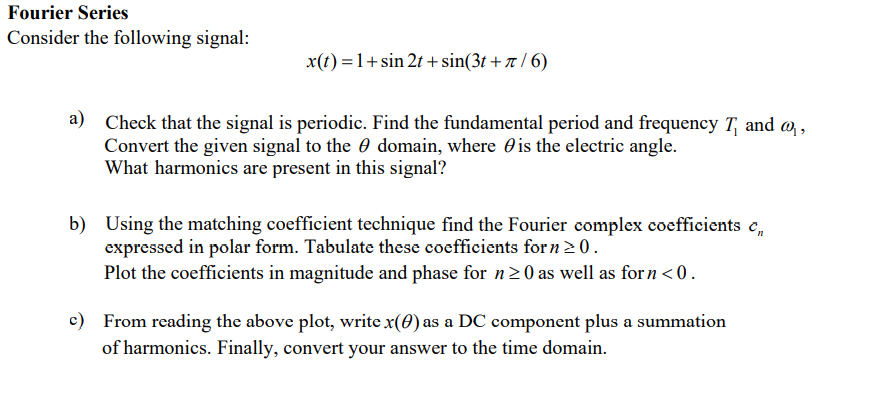Fourier Series Consider the following signal: x(t) =1+sin 2t + sin(3t +x / 6) a) Check that the signal is periodic. Find the fundamental period and frequency T and w , Convert the given signal to the 0 domain, where 0 is the electric angle. What harmonics are present in this signal? b) Using the matching coefficient technique find the Fourier complex coefficients c, expressed in polar form. Tabulate these coefficients for n2 0. Plot the coefficients in magnitude and phase for n20 as well as for n<0. c) From reading the above plot, write x(0) as a DC component plus a summation of harmonics. Finally, convert your answer to the time domain.
Fourier Series Consider the following signal: x(t) =1+sin 2t + sin(3t +x / 6) a) Check that the signal is periodic. Find the fundamental period and frequency T and w , Convert the given signal to the 0 domain, where 0 is the electric angle. What harmonics are present in this signal? b) Using the matching coefficient technique find the Fourier complex coefficients c, expressed in polar form. Tabulate these coefficients for n2 0. Plot the coefficients in magnitude and phase for n20 as well as for n<0. c) From reading the above plot, write x(0) as a DC component plus a summation of harmonics. Finally, convert your answer to the time domain.
Introductory Circuit Analysis (13th Edition)
13th Edition
ISBN:9780133923605
Author:Robert L. Boylestad
Publisher:Robert L. Boylestad
Chapter1: Introduction
Section: Chapter Questions
Problem 1P: Visit your local library (at school or home) and describe the extent to which it provides literature...
Related questions
Question
Please help solve the question shown in the photo. There is only 1 problem, but it has three parts to it. I want to know how to solve all parts completely so please show all steps clearly. Thank you.

Transcribed Image Text:Fourier Series
Consider the following signal:
x(t) = 1+ sin 2t + sin(3t + a / 6)
a) Check that the signal is periodic. Find the fundamental period and frequency T and @ ,
Convert the given signal to the 0 domain, where Ois the electric angle.
What harmonics are present in this signal?
b) Using the matching coefficient technique find the Fourier complex coefficients c,
expressed in polar form. Tabulate these coefficients for n20.
Plot the coefficients in magnitude and phase for n20 as well as for n < 0.
c) From reading the above plot, write x(0) as a DC component plus a summation
of harmonics. Finally, convert your answer to the time domain.
Expert Solution
This question has been solved!
Explore an expertly crafted, step-by-step solution for a thorough understanding of key concepts.
This is a popular solution!
Trending now
This is a popular solution!
Step by step
Solved in 4 steps with 4 images

Knowledge Booster
Learn more about
Need a deep-dive on the concept behind this application? Look no further. Learn more about this topic, electrical-engineering and related others by exploring similar questions and additional content below.Recommended textbooks for you

Introductory Circuit Analysis (13th Edition)
Electrical Engineering
ISBN:
9780133923605
Author:
Robert L. Boylestad
Publisher:
PEARSON

Delmar's Standard Textbook Of Electricity
Electrical Engineering
ISBN:
9781337900348
Author:
Stephen L. Herman
Publisher:
Cengage Learning

Programmable Logic Controllers
Electrical Engineering
ISBN:
9780073373843
Author:
Frank D. Petruzella
Publisher:
McGraw-Hill Education

Introductory Circuit Analysis (13th Edition)
Electrical Engineering
ISBN:
9780133923605
Author:
Robert L. Boylestad
Publisher:
PEARSON

Delmar's Standard Textbook Of Electricity
Electrical Engineering
ISBN:
9781337900348
Author:
Stephen L. Herman
Publisher:
Cengage Learning

Programmable Logic Controllers
Electrical Engineering
ISBN:
9780073373843
Author:
Frank D. Petruzella
Publisher:
McGraw-Hill Education

Fundamentals of Electric Circuits
Electrical Engineering
ISBN:
9780078028229
Author:
Charles K Alexander, Matthew Sadiku
Publisher:
McGraw-Hill Education

Electric Circuits. (11th Edition)
Electrical Engineering
ISBN:
9780134746968
Author:
James W. Nilsson, Susan Riedel
Publisher:
PEARSON

Engineering Electromagnetics
Electrical Engineering
ISBN:
9780078028151
Author:
Hayt, William H. (william Hart), Jr, BUCK, John A.
Publisher:
Mcgraw-hill Education,